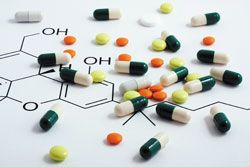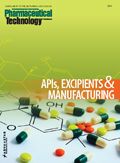Gaining Insights on Contract Chemical API Manufacturing An Industry Roundtable
Industry experts share their views on the outsourcing model and the current and future direction of contract chemical API manufacturing.

As fine-chemical companies, contract manufacturers, and pharmaceutical companies gather in Frankfurt for CPhI Worldwide, on Oct. 22-24, a fundamental question is on the minds of exhibitors and attendees alike: namely, what is the current and future direction of the industry? To answer that question, Pharmaceutical Technology gained the views of chemical API manufacturers on the key issues shaping the pharmaceutical industry and their impact on supply-demand fundamentals for contract small-molecule manufacturing and the outsourced relationship. Participating in the roundtable were: Susan Daly, PhD, and API technical manager, Aesica Pharmaceuticals; Kurt Hoeprich, global business manager, pharmaceuticals, Albemarle; Brian Scanlan, CEO and president of Cambridge Major Laboratories; Mark Griffiths, CEO, the Dishman Group of Companies; and Andreas Weiler, PhD, head of global strategic marketing, contract manufacturing services and solutions, SAFC.
The state of the industryPharmTech: In looking at the market for fine chemicals and contract API manufacturing, what are the key factors affecting supply and demand? How would you assess the current market and the near-term outlook?

Weiler (SAFC): Demographics, life expectancy, and the fact that the ‘pharmerging’ countries will double their medicine spending within the next five years will increase the global demand of pharmaceuticals. Healthcare cost-saving programs in the developed countries and patent expiries, however, will accelerate the use of generics, so by 2014, 85% of all drugs by volume will be generics.
Nevertheless, we have seen an increase in approvals of new molecular entities (NMEs) to 30 and 39, respectively in 2011 and 2012 compared with 21 NMEs approved in 2010, with approximately 70% of these small-molecule drugs. We strongly believe that this trend, together with an increase in biological drugs, will continue as we are facing a paradigm shift from general care (i.e., blockbusters) to more specialist care drugs.

Daly (Aesica): The trend for Large Pharma to concentrate on their core competencies continues, which increases the opportunity for CDMOs. Large pharma companies continue to divest their sites, and as a result, continue to increase their outsourcing requirements. There are certain additional complexities, such as potent capabilities, which are not typically available in-house to large pharma organizations. There is a growing trend for large pharma to outsource potent drug handling to CDMOs that have the established infrastructure and expertise to manage such complexities. Additionally, the growing importance of the BRIC countries (Brazil, Russia, India, and China) and the Next Eleven (N-11) (Bangladesh, Egypt, Indonesia, Iran, South Korea, Mexico, Nigeria, Pakistan, the Philippines, Turkey, and Vietnam) economies is leading all pharmaceutical companies to develop strategies for these markets. Also, biotechs and virtual companies offer a source of innovation and are a key source of new drug development. Typically, these companies have limited or no manufacturing capabilities in house. The financial environment is now becoming more favorable, allowing smaller companies easier access to more funding opportunities and biotech firms to outsource to CDMOs.

Scanlan (Cambridge Major Laboratories): At Cambridge Major Laboratories, we definitely see a trend toward increased outsourcing. Whether for cost-containment reasons or to access specific expertise, we know that the outsourcing model is here to stay. What’s really interesting is that in spite of significant offshore investment by Large Pharma and by large CMOs, we notice a trend of demand returning to the United States. The cost advantage once promised by offshoring has eroded, and recent quality issues have generated concern for employee safety, patient safety, and overall project risk. When you factor the increased number of NCEs with permeability and solubility issues and those that require higher containment, the field of choices for API manufacturers that possess these capabilities, to a sufficient degree, narrows significantly. Because nearly two-thirds of drugs from the synthesis stage have low solubility (< 0.1 mg/mL), API manufacturers that offer solid-state chemistry services possess a critical advantage in the current market. Similarly, those with collective experience and expertise in handling high-potency APIs are well poised to take share in the rapidly growing submarket currently experiencing almost double-digit growth. Overall, the current market for contract API manufacturing is robust, and the near-term outlook is positive for companies with a customer-service focus, strong quality record, and sufficient productivity to ensure global cost competitiveness.

Griffiths (Dishman Group): There has been a return of venture-capital funding of small and emerging biopharmaceutical companies, which is enabling the funding of innovative research into new therapies. Over the past two years, our early-phase development capabilities have been extensively occupied with new candidates for small and medium biopharma companies. This is encouraging as, even given the attrition rate at the end of Phase II and into Phase III, there will be a number of NCEs being launched from our facilities in the next 18 months. We continue to invest in additional capabilities, such as high-potency high-performance liquid chromatography (HPLC), antibody-drug conjugate capabilities, and semi and fully automated early-phase parenteral fill-finish. Just doing the same thing will not grow our business; we have to innovate alongside our clients.
PharmTech: The industry as a whole has faced certain large issues, such as pharmaceutical industry restructuring, the increased role of generic drugs, greater strategic importance for emerging markets, and an increased focus on biologic-based drug development. What have been the implications for small-molecule drug development and commercialization, and what other factors are influencing the paradigm for small-molecule drug development and commercialization?
Weiler (SAFC): As a consequence of the upcoming patent cliff and the loss of approximately $120 billion, we have seen many mergers and consolidations within Big Pharma. Cost pressure forced many companies to shift parts of their small-molecule API manufacturing to Asia; others have started to use their empty-reactor capacity to compete in the CMO industry. All this was accompanied by a significant drop in
small-molecule new drug approvals from 2000 to 2010, creating approximately 40% production overcapacity.
The increase in new drug approvals over the past two years is mainly driven by innovative therapeutics anticipated for cancer, Alzheimer’s disease, diabetes, orphan diseases, and biological-derived drugs, which will represent one-third of all branded drug sales within the next five years. Many of these new drugs are extremely potent and require highly sophisticated production technologies. In other words, they’re difficult to make and even more difficult to copy, which is the reason they’re a perfect fit for Western CMOs.
Daly (Aesica): There is recognition within the industry that biologic-based drug development is increasing and becoming more prominent in the strategies of Large Pharma. Outsourcing of biologic development and manufacture, although a growing market, is not as mature as the outsourcing of small-molecule drug development and manufacture. There continues to be growth in the small-molecule sector, and outsourcing of biologics is not currently forecast to overtake small-molecule development in the short to medium term as large pharma organizations tend to keep biologic projects in-house.

Hoeprich (Albemarle): To deliver the highest quality products and fully comply with regulatory requirements, the major trend we have observed is the need to efficiently conduct comprehensive process development by adhering to the quality-by-design approach described in guidance documents from FDA. With this approach to development, we commonly exploit design of experiments to ensure a thorough understanding of the process design space and establish validation protocols for robust and reliable commercial-scale production. Albemarle has continued to invest in multi-unit reactor systems and analytical tools to efficiently execute this comprehensive approach to process development and scale-up. Additionally, we see an increasing need to qualify key raw-material suppliers through in-person audits of production facilities, regardless of location. Albemarle’s global presence, which includes a team of sourcing professionals based in China, has facilitated rapid in-person quality audits of key raw-material suppliers.
Scanlan (Cambridge Major Laboratories): It is certainly the case that Large Pharma continues to divest noncore assets, which drives increased overall demand for contract pharmaceutical manufacturing. Emerging markets, such as India and China, have seen strong recent growth due to a rise in demand for generic drugs, and of course, biosimilars are driving expertise-based outsourcing for biologic-based drug development.
Yet, with respect to proprietary APIs, there is definitely an odd phenomenon in the chemical manufacturing industry. Although the majority of proprietary drugs are developed in North America and North America continues to be the largest pharmaceutical marketplace in the world, the bulk of development and manufacturing of chemical assets do not occur in this region. The pharmaceutical chemistry development industry has evolved in a way that is out of sync with the market at large, but we are starting to see the market swing back into sync. We see regional price differences leveling off, and concerns about quality and security of intellectual property driving demand back to first-world markets and investment in core API infrastructure, particularly in North America. In Europe, excess capacity and the age of facilities drive price competition; however, there is still a lack of quality assets in Europe. Meanwhile, recent facility expansions, commitment to employee and environmental safety, ease of communication, and disciplined project management have resulted in strengthened demand in North America for small-molecule drug development and commercial manufacture.
Griffiths (Dishman Group): I think that Large Pharma has actually always been in the midst of restructuring, certainly in my 30 years in the industry, but the rate of change has increased during the past three years. Where will it end? I guess it will, depending on a complex number of factors that affect Large Pharma’s in varying degrees: R&D output, a rise in costs that affects all of us, regulatory pushback, government pricing policy for new drugs, and access to reasonable patent durations. Ten years ago, Large Pharma set the tone for the outsourced market. I think this has fundamentally changed, and the more ‘aggressive,’ fast-on-their-feet, small and medium biopharm companies certainly set the tone for much of what we do in the Dishman Group and especially at the Carbogen-Amcis boundary. We are constantly challenged to think outside the box by our clients, and this has raised our game as a supplier and innovator, a very rewarding set of circumstances where there is the chance to really form partnerships predicated on mutual need and a desire to focus on the needs of the patient.
PharmTech: How have the expectations between contract manufacturers and their sponsor companies changed in terms of technical capabilities, geographic/global capabilities, and in managing the outsourced relationship?
Griffiths (Dishman): The ‘old strategic partnership model’ was never really going to work as there was a fundamental need on the part of us (i.e., the CMOs) but a much lower ‘need’ from the outsourcing company. We, as CMOs, fought among ourselves cutting price to compete, and this ultimately benefitted the outsourcing company, not our own businesses. Fundamentally, a partnership relies on elements of mutual need, common goals, and the understanding that both parties are completely open about key elements for each program. In the end, meeting all the deliverables, on time, on quality, and on budget are the key metrics, but great science, project management, flexibility on our part, and an absolute passion for communication get these metrics met.
Daly (Aesica): The relationships between sponsor companies and CDMOs have moved from tactical to more strategic relationships due to pharmaceutical companies continuing to reduce their number of suppliers and developing a fewer number of more preferred partner relationships. This continuing trend within the industry will drive consolidation within the contract manufacturing space.
Hoeprich (Albemarle): As regulatory requirements increase and the number of activities an API manufacturer must conduct becomes greater and more complex, we see more strategic relationships developing. We believe this is due to time savings and resource-utilization benefits that can be gained from working with one entity that can conduct comprehensive process development and a full range of validation activities and commercial-scale production while still managing all key raw-material sourcing. In our opinion, there is a push to utilize one supplier for all development needs and commercial manufacturing rather than parcel out numerous tasks to multiple suppliers and service providers.
Weilers (SAFC): The increased complexity of new drugs makes it important for sponsors and CMOs to work hand in hand building strategic partnerships, sharing best practices, and developing solutions together with the aim of increasing their productivity and shortening the time to market.
In the case of some sponsor companies, however, we’re seeing more of a shift away from the partnership model and a main focus on cost savings as the key drivers in their relationships. It will be very interesting to see what model will be more successful in future years.
Scanlan (Cambridge Major Laboratories): We absolutely see trends toward supplier consolidation and outsourcing according to project complexity, and we give a great deal of thought to what makes a partner versus a transactional supplier. At the minimum, a partner should offer the full breadth of capabilities required so that the ability to deliver project results on time is never compromised. For some of our customers, this means the ability to take a compound from preclinical through commercial manufacture at a single site, regardless of whether that site is in North America or Europe. For other customers, this means ensuring that our analytical and quality-assurance departments have equal strength to our chemistry development and manufacturing capabilities, so that we identify and resolve potential issues quickly with timely communication. And for others, it means adopting a service mentality--the ability to remain flexible and responsive in the face of changing demands. This flexibility is especially important for early-development projects where client requirements or process R&D decisions can change, but it is also important for late-phase projects where continued engagement and optimization adds value.
PharmTech: In looking ahead five years from now, how will the model for contract API manufacturing and fine-chemical manufacturing be the same? How might it be different? What do you think will be the key issues of the future affecting small-molecule drug development and commercialization, including the model for contract manufacturing?
Weilers (SAFC): Currently, less than 20% of all drugs in the clinical pipeline are innovated by Big Pharma, yet some of these companies have a lot more internal focus. They have their own scientific experts, which can create a challenging environment for a CMO. The remaining 80% (more than 8000) of drugs are originated at virtual, small, and mid-sized pharma companies. Many of those companies have no desire to build up internal capacity or know-how. They are in need of advice and are looking to build strategic partnerships with their CMOs with the goal of increasing productivity and getting their complex drugs to market faster.
A key issue for the regulatory authorities will be finding a solution to handle an increasing number of new drug approvals with smaller and narrower patient populations. In many cases, there will be increased diagnostic requirements to test the drugs, and in some cases, companies will be seeking fast-track or orphan-drug status. This change will require a refined and strategic approach to approvals, including new resources in the approval process.
Daly (Aesica): The industry will see more large pharma companies working with fewer, more strategic partners, resulting in further consolidation within the marketplace. The drive toward fewer partners will see Large Pharma looking for CDMOs with a full service of development and manufacturing services for API and formulated products.
Hoeprich (Albemarle): We believe biotechnology and pharmaceutical companies will continue to increase the number of small molecules outsourced for process development, scale-up, and commercial production. Also, we believe developments, such as the Generic Drug User Fee Act, will enable faster and more predictable reviews of applications and supplements and that this will ultimately benefit patients in terms of availability of needed medications that have been produced at facilities that are consistently inspected by FDA.
Scanlan (Cambridge Major Laboratories): The current global CMO landscape is heavily fragmented, and it can be difficult to determine clear points of difference among firms. Five years from now, I think we will be seeing a more consolidated industry where firms have differentiated themselves more clearly in approach to quality, ease of doing business, proprietary expertise, and the ability to deliver solutions in areas of more rapidly growing demand, such as more complex chemistries, high-potency APIs, improved analytical capabilities, and small-volume manufacturing.
Griffiths (Dishman): I am surprised that so many of us in the CMO world have managed to survive since 2008, a testament in some way to the tenacity and capability of our subset of the pharma industry. Survival in the future, however, will depend on being diversified in customer bases, technology, and capabilities (i.e., API, formulation, small-molecule, and biologics) as well as having a global presence and most importantly, having the best possible scientists, project managers, and courageous leadership. Analytical capability is becoming a real differentiator. The bar for data supporting the ‘white powder’ has been raised significantly by the regulatory agencies, so having a few HPLC and gas chromatography systems in a laboratory just isn’t going to be enough these days. Having the expertise to interpret data is already key, and this need will increase.

Drug Solutions Podcast: A Closer Look at mRNA in Oncology and Vaccines
April 30th 2024In this episode fo the Drug Solutions Podcast, etherna’s vice-president of Technology and Innovation, Stefaan De Koker, discusses the merits and challenges of using mRNA as the foundation for therapeutics in oncology as well as for vaccines.